Mises, Ludwig von. Human Action: A Treatise on Economics
Подождите немного. Документ загружается.

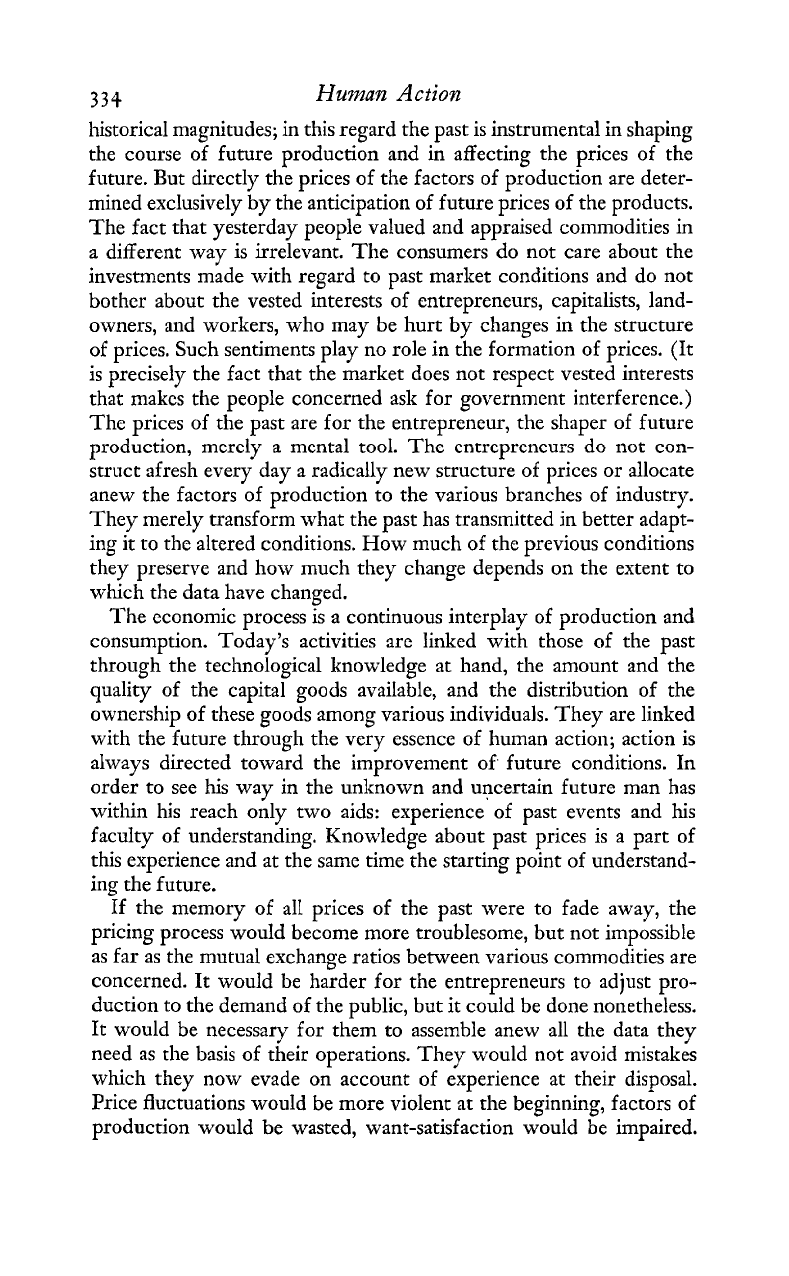
334
Humam
Action
historical magnitudes; in this regard the past is instrumental in shaping
the course of future production and in affecting the prices of the
future. But directly the prices of the factors of production are deter-
mined exclusively by the anticipation of future prices of the products.
The fact that yesterday people valued and appraised commodities in
a different way is irrelevant. The consumers do not care about the
investments made with regard to past market conditions and do not
bother about the vested interests of entrepreneurs, capitalists, land-
owners, and workers, who may be hurt by changes in the structure
of prices. Such sentiments play no role in the formation of prices. (It
is precisely the fact that the market does not respect vested interests
that makes the people concerned ask for government interference.)
Thc prices of the past are for the entrepreneur, the shaper of future
production, merely
a
mental tool. The entrepreneurs do not con-
struct afresh every day a radically new structure of prices or allocate
anew the factors of production to the various branches of industry.
They merely transform what the past has transmitted in better adapt-
ing it to the altered conditions. How much of the previous conditions
they preserve and how much they change depends on the extent to
which the data have changed.
The cconomic process is a continuous interplay of production and
consumption. Today's activities are linked with those of the past
through the technological knowledge at hand, the amount and the
quality of the capital goods available, and the distribution of the
ownership of these goods among various individuals. They are linked
with the future through the very essence of human action; action is
always directed toward the improvement of future conditions. In
order to see his way in the unknown and uncertain future man has
within his reach only two aids: experience of past events and his
faculty of understanding. Knowledge about past prices is a part of
this experience and at the same time the starting point of understand-
ing
-
the future.
If the memory of all prices of the past were to fade away, the
pricing process would become more troublesome, but not impossible
as far as the mutual exchange ratios between various commodities are
concerned. It would be harder for the entrepreneurs to adjust pro-
duction to the demand of the public, but it could be done nonetheless.
It would be necessary for them to assemble anew all the data they
need as the basis of their operations. They would not avoid mistakes
which they now evade on account of experience at their disposal.
Price fluctuations would be more violent at the beginning, factors of
production would be wasted, want-satisfaction would be impaired.
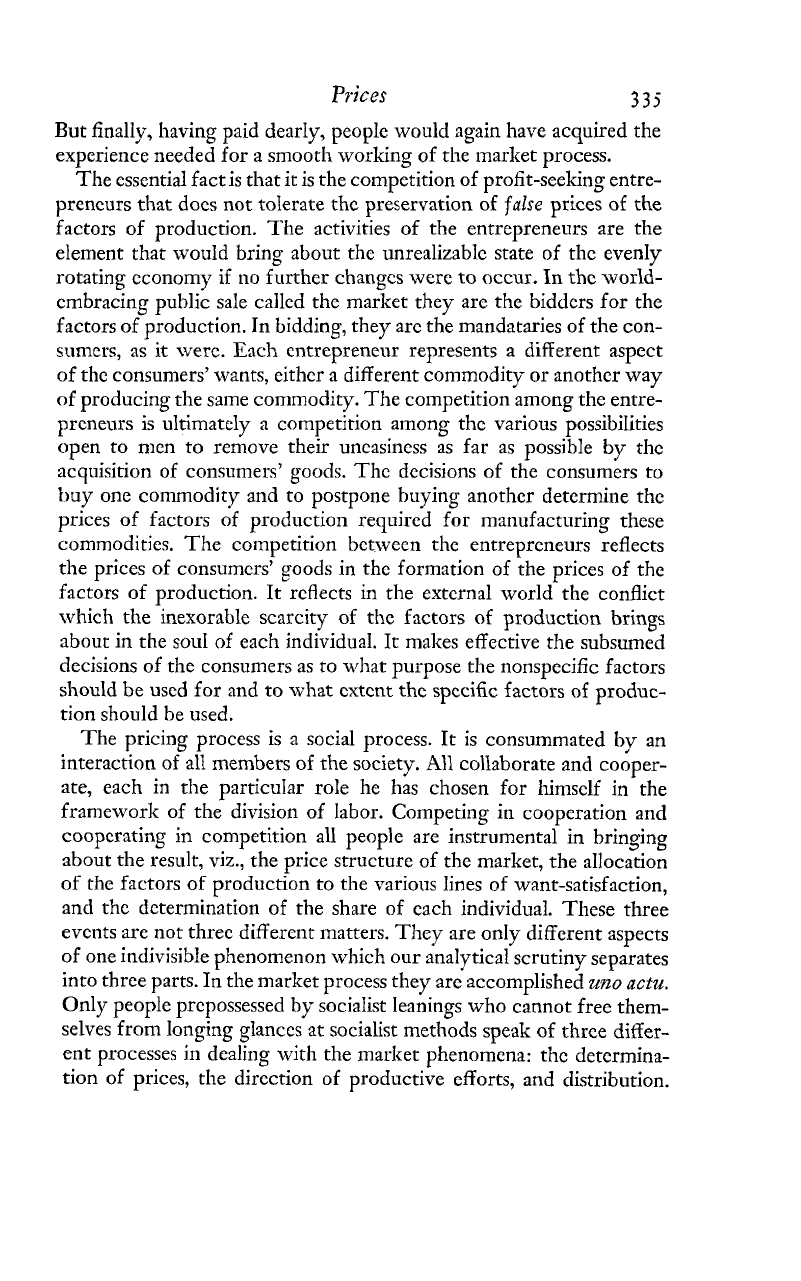
But finally, having paid dearly, people would again have acquired the
experience needed for a smooth working of the market process.
The essential fact is that it is the competition of profit-seeking entre-
preneurs that docs not tolerate the preservation of
false
prices of
the
factors of production. The activities of the entrepreneurs are the
element that would bring about the
unrealizable
state of the evenly
rotating cconomy if no further changes werc to occur. In the world-
embracing public sale called the market they arc the bidders for the
factors of production. In bidding, they arc the mandataries of the con-
sumers, as it werc. Each entrepreneur represents a different aspect
of the consumers' wants, either a different commodity or another way
of producing the same commodity. The competition among the entre-
preneurs is ultimately a competition among the various possibilities
open to men to remove their uneasiness as far as possible by the
acquisition of consumers' goods. The decisions of the consumers to
tmy one commodity and to postpone buying another determine the
prices of factors of production required for manufacturing these
commodities. The competition between the entrepreneurs reflects
the prices of consumers' goods in the formation of the prices of the
factors of production. It reflects in the external world the conflict
which the
inexorable
scarcity of the factors of production brings
about in the soul of each individual. It makes effective the subsumed
decisions of the consumers as to what purpose the nonspecific factors
should be used for and to what extent the spccific factors of produc-
tion should be used.
The pricing process is a social process. It is consummated by an
interaction of all members of the society. All collaborate and cooper-
ate, each in the particuIar role he has chosen for himself in the
framework of the division of labor. Competing in cooperation and
coopcrating in competition all people are instrumental in bringing
about the result, viz., the price structure of the market, the allocation
of the factors of production to the various lines of want-satisfaction,
and the determination of the share of each individual. These three
events are not three different matters. They are only different aspects
of one indivisible phenomenon which our analytical scrutiny separates
into three parts. In the market process they arc accomplished
uno
actu.
Only people prepossessed by sociaIist leanings who cannot free them-
selves from longing glances at socialist methods speak of three differ-
ent processes
in
dealing with the market phenomena: thc detcrmina-
tion of prices, the direction of productive efforts, and distribution.
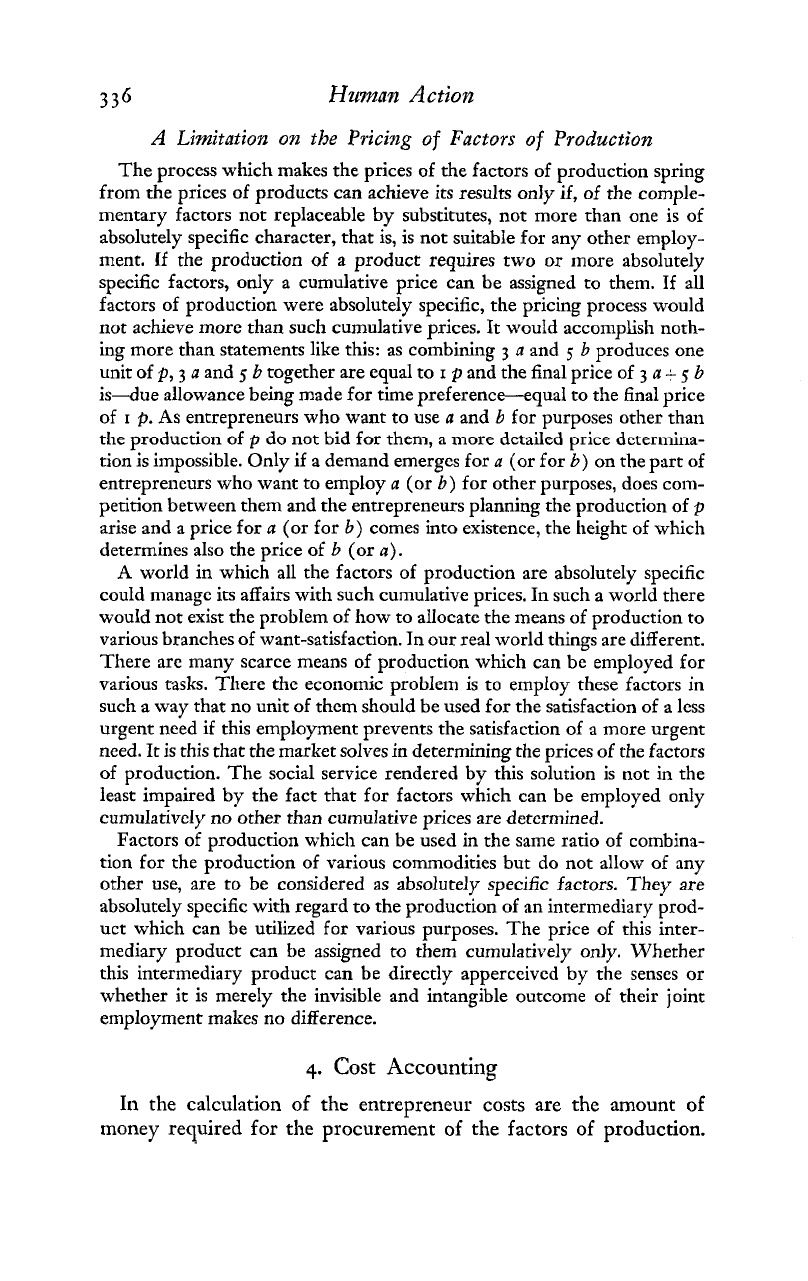
3
36
Human
Action
A
Limitation
on
the Pricing
of
Factors
of Production
The process which makes the prices of the factors of production spring
from the prices of products can achieve its results only
if, of the comple-
mentary factors not replaceable by substitutes, not more than one is of
absolutely specific character, that is, is not suitable for any other employ-
ment. If the production of a product requires two or more absolutely
specific factors, only a cumulative price can be assigned to them. If all
factors of production were absolutely specific, the pricing process would
not achieve more than such cumulative prices. It would accomplish noth-
ing more than statements like this: as combining
3
a
and
5
b
produces one
unit of
p,
3
a
and
5
b
together are equal to
I
p
and the final price of
3
a
1
5
b
is--due allowance being made for time preference-equal to the final price
of
I
p.
As entrepreneurs who want to use
a
and
b
for purposes other than
the production of
p
do not bid for them, a more detailed price dctermina-
tion is impossible. Only if a demand emerges for
a
(or for
b)
on the part of
entrepreneurs who want to employ
a
(or
b)
for other purposes, does com-
petition between them and the entrepreneurs planning the production of
p
arise and a price for
a
(or for b) comes into existence, the height of which
determines also the price of
b
(or
a).
A world in which all the factors of production are absolutely specific
could manage its affairs with such cumulative prices. In such a world there
would not exist the problem of how to allocate the means of production to
various branches of want-satisfaction. In our real world things are different.
There are many scarce means of production which can be employed for
various tasks. There the economic problem is to employ these factors in
such a way that no unit of them should be used for the satisfaction of a less
urgent need if this employment prevents the satisfaction of a more urgent
need. It is this that the market solves in determining the prices of the factors
of production. The social service rendered by this solution is not in the
least impaired by the fact that for factors which can be employed only
cumuIativcly no other than cumulative prices are determined.
Factors of production which can be used in the same ratio of combina-
tion for the production of various commodities but do not allow of any
other use, are to be considered as absolutely specific factors.
They
are
absolutely specific with regard to the production of an intermediary prod-
uct which can be utilized for various purposes. The price of this inter-
mediary product can be assigned to them cumulatively only. Whether
this intermediary product can be directly apperceived by the senses or
whether it is merely the invisible and intangible outcome of their joint
employment makes no difference.
4.
Cost Accounting
In
the calculation of the entrepreneur costs are the amount of
money required for the procurement of the factors of production.
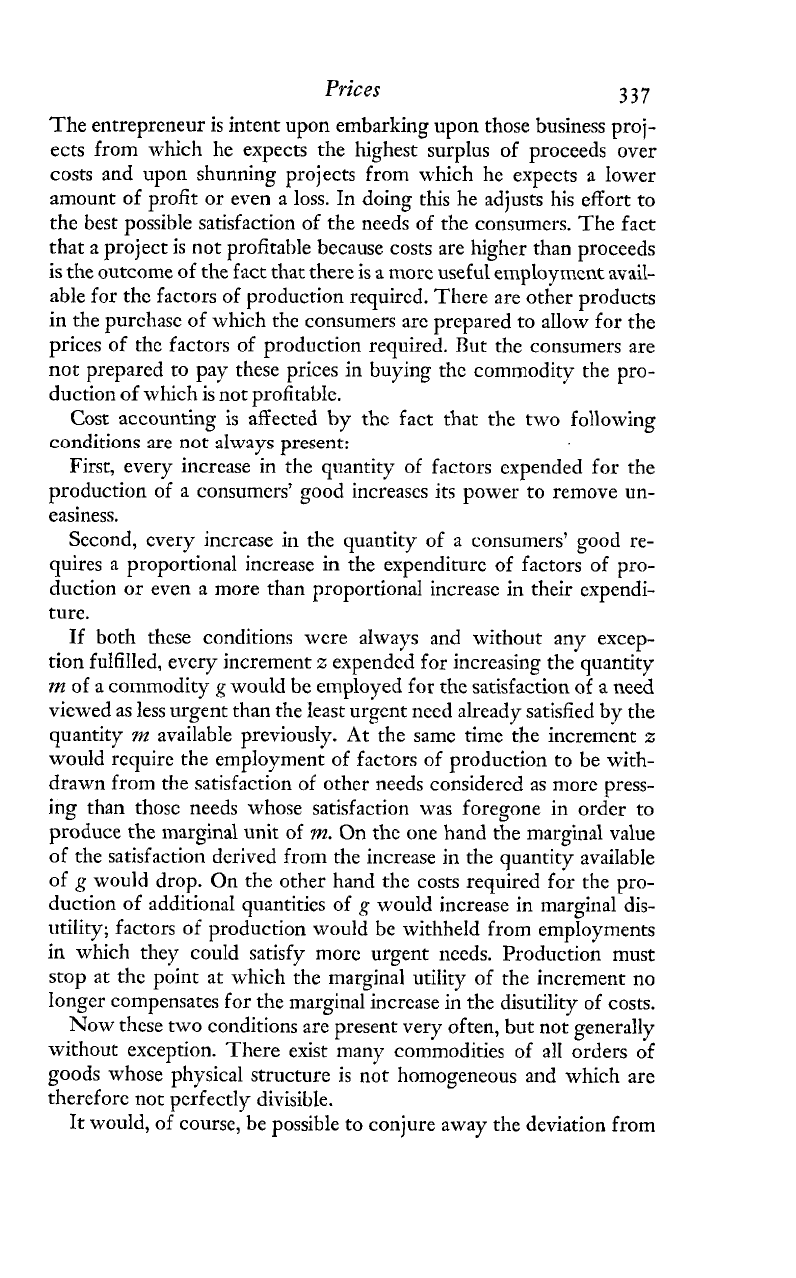
Prices
337
The entrepreneur is intent upon embarking upon those business proj-
ects from which he expects the highest surplus of proceeds over
costs and upon shunning projects from which he expects a lower
amount of profit or even a loss. In doing this he adjusts his effort to
the best possible satisfaction of the needs of the consumers. The fact
that a project is not profitable because costs are higher than proceeds
is the outcome of the fact that there is a more useful employment avail-
able for the factors of production requircd. There are other products
in the purchase of which the consumers are prcpared to allow for the
prices of the factors of production required. But the consumers are
not prepared to pay these prices in buying the commodity the pro-
duction of which is not profitable.
Cost accounting is affected by thc fact that the two following
conditions are not always present:
First, every incrcase
in
the quantity of factors cxpended for the
production of a consumers' good increases its power to remove un-
easiness.
Second, cvery incrcase in the quantity of a consumers' good re-
quires a proportional increase in the expenditure of factors of pro-
duction or even a more than proportional increase in their expendi-
ture.
If both thcse conditions were always and without any excep-
tion fultiIled, every increment
z
expendcd for increasing the quantity
7n
of
a
commodity g would be employed for the satisfaction of
a
need
viewed as less urgent than the ieast urgent nced already satisfied by the
quantity
m
available previously. At the same time the increment
z
would require the employment of factors of production to be with-
drawn from the satisfaction of other needs considered as more press-
ing than thosc needs whose satisfaction was foregone in order to
produce the marginal unit of
m.
On the one hand the marginal value
of the satisfaction derived from the increase in the quantity available
of
g
would drop. On the other hand the costs required for the pro-
duction of additiond quantities of
g
would increase in marginal dis-
utility; factors of production would be withheld from employments
in which they could satisfy morc urgent needs. Production must
stop at the point at which the marginal utility of the increment no
longer compensates for the marginal increase in the disutility of costs.
Now these two conditions are present very often, but not generally
without exception. There exist many commodities of a11 orders of
goods whose physical structure is not homogeneous and which are
therefore not perfectly divisible.
It would, of course, be possible to conjure away the deviation from
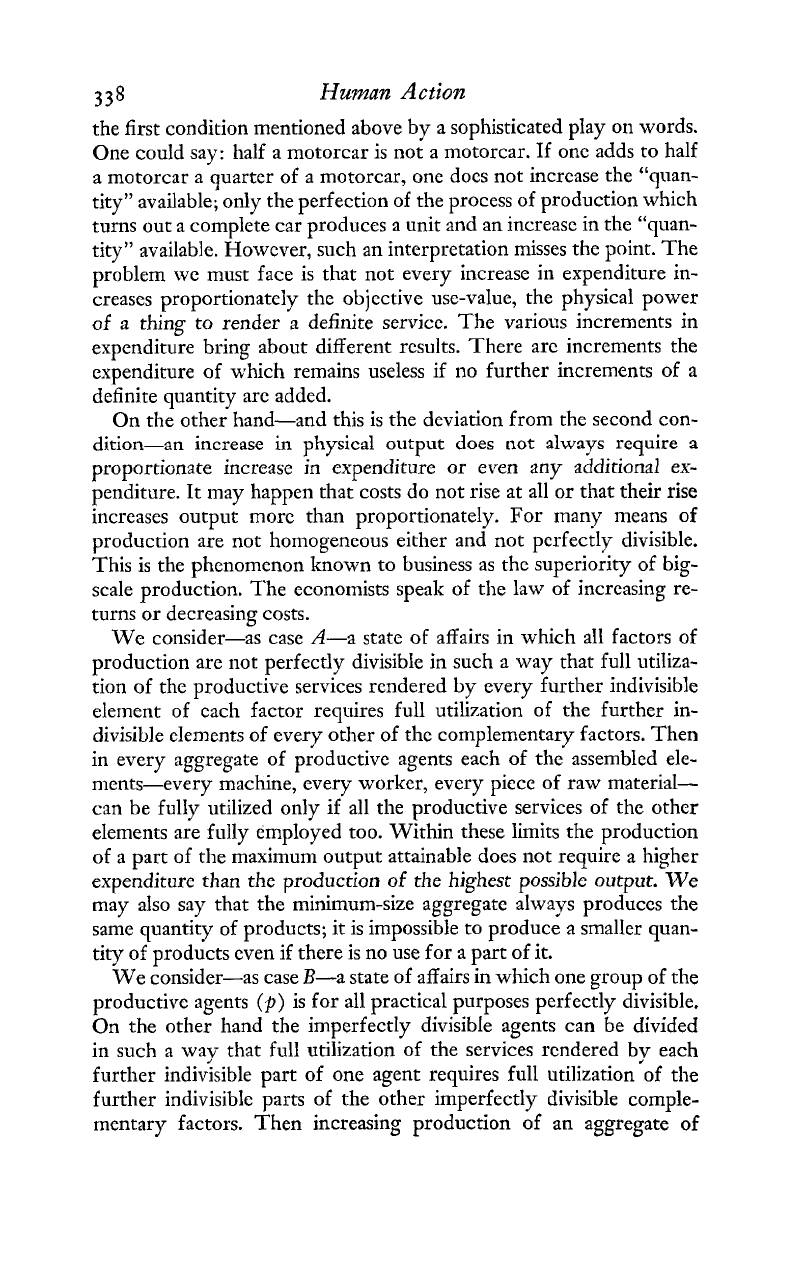
3
38
Human
Action
the first condition mentioned above by a sophisticated play on words.
One could say: half a motorcar is not a motorcar. If one adds to half
a motorcar a quarter of a motorcar, one does not increase the "quan-
tity" available; only the perfection of the process of production which
turns out a complete car produces a unit and an increase in the "quan-
tity" available. However, such an interpretation misses the point. The
problem we must face is that not every increase in expenditure in-
creases proportionately the objective use-value, the physical power
of a thing to render
a
definite service. The various increments in
expenditure bring about different results. There arc increments the
expenditure of which remains useless if no further increments of a
definite quantity arc added.
On the other hand-and this is the deviation from the second con-
dition-an increase in physical omput does not always require a
proportionate increase in cxpenditurc or even any additional
ex-
penditure. It may happen that costs do not rise at all or that their rise
increases output more than proportionately. For many means of
production are not homogeneous either and not pcrfec;ly divisible.
This is the phenomenon known to business as the superiority of big-
scale production. The economists speak of the law of increasing re-
turns or decreasing costs.
Wc consider-as case A-a state of affairs in which ail factors of
production are not perfectly divisible in such a way that full utiliza-
tion of the productive services rendered
by
every further indivisible
element of each factor requires full utilization of the further in-
divisible elements of every other of the conlplementary factors. Then
in every aggregate of productive agents each of the assembled ele-
ments-every machine, every worker, every piece of raw material-
can be fully utilized only if all the productive services of the other
elements are fully employed too. Within these limits the production
of a part of the maximum output attainable does not require a higher
expenditure than the production
of
the
highest possible output.
We
may also say that the minimum-size aggregate always produces the
same quantity of products; it is impossible to produce a smaller quan-
tity of products even if there is no use for a part
of
it.
We consider-as case B-a state of affairs in which one group of the
productive agents
(p)
is for all practical purposes perfectly divisible.
On the other hand the imperfectly divisible agents can be divided
in such a way that full utilization of the services rcndered by each
further indivisible part of one agent requires full utilization of the
further indivisible parts of the other imperfectly divisible comple-
mentary factors. Then increasing production of
an
aggregate of
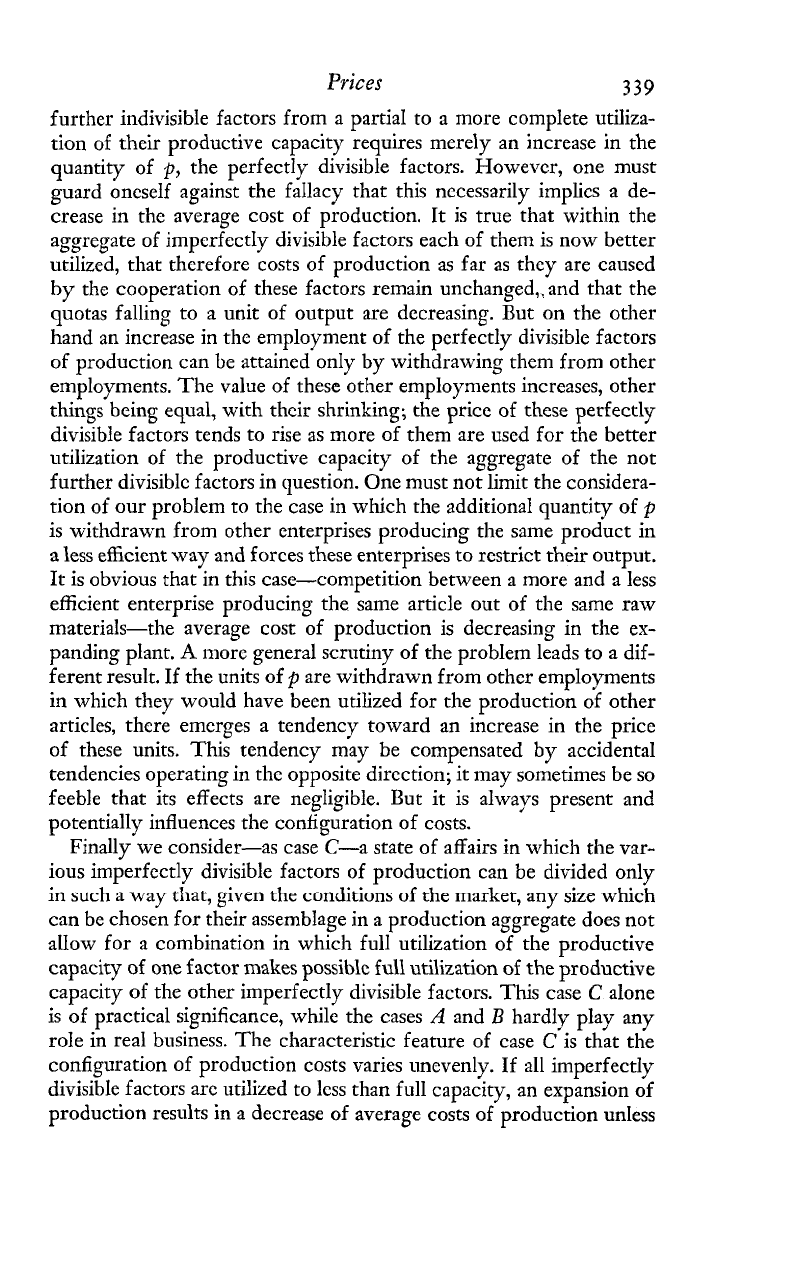
Prices
339
further indivisible factors from a partiaI to a more complete utiliza-
tion of their productive capacity requires merely an increase in the
quantity of
p,
the perfectly divisible factors. However, one must
guard oneself against the fallacy that this necessarily implies a de-
crease in the average cost of production. It is true that within the
aggregate of imperfectIy divisible factors each of them is now better
utilized, that therefore costs of production as far as they are caused
by the cooperation of these factors remain unchanged,. and that the
quotas falling to a unit of output are decreasing. But on the other
hand an increase in the employment of the perfectly divisible factors
of production can be attained only by withdrawing them from other
employments. The value of these other employments increases, other
things being equal, with their shrinking; the price of these perfectly
divisible factors tends to rise as more of them are used for the better
utilization of the productive capacity of the aggregate of the not
further divisible factors in question. One must not limit the considera-
tion of our problem to the case in which the additional quantity of
p
is withdrawn from other enterprises producing the same product in
a
less efficient way and forces these enterprises to restrict their output.
It is obvious that in this case-competition between a more and a less
efficient enterprise producing the same article out of the same raw
materials-the average cost of production is decreasing in the ex-
panding plant.
A
more general scrutiny of the problem leads to a dif-
ferent result. If the units of
p
are withdrawn from other employments
in which they would have been utilized for the production of other
articles, there emerges a tendency toward an increase in the price
of these units. This tendency may be compensated by accidental
tendencies operating in the opposite direction; it may sometimes be so
feeble that its effects are negligible. But it is always present and
potentially influences the configuration of costs.
Finally we consider-as case C-a state of affairs in which the var-
ious imperfectly divisible factors of production can be divided only
in
such a way that, given the conditions of the market, any size which
can be chosen for their assemblage in a production aggregate does not
alIow for a combination in which full utilization of the productive
capacity of one factor makes possible full utilization of the productive
capacity of the other imperfectly divisible factors. This case
C
alone
is of practical significance, while the cases
A
and
B
hardly play any
role in real business. The characteristic feature of case
is
that the
configuration of production costs varies unevenly. If all imperfectly
divisible factors are utilized to lcss than full capacity, an expansion of
production res~~lts in a decrease of average costs of production unless
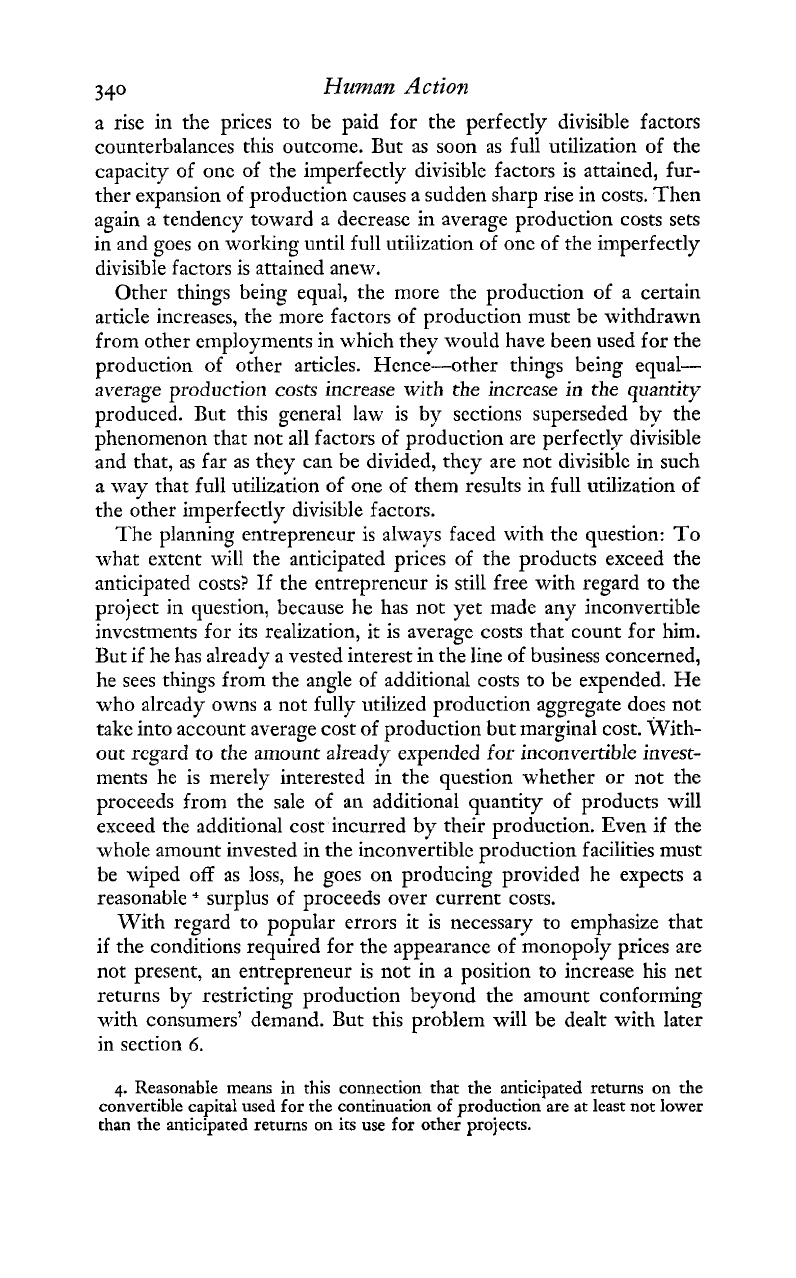
340
Human
Action
a rise in the prices to be paid for the perfectly divisible factors
counterbalances this outcome.
But
as soon as full utilization of the
capacity of one of the imperfectly divisible factors is attained, fur-
ther expansion of production causes a sudden sharp rise in costs. Then
again a tendency toward a decrease in average production costs sets
in and goes on working until full utilization of one of the imperfectly
divisible factors is attained anew.
Other things being equal, the more the production of a certain
article increases, the more factors of production must be withdrawn
from other employments in which they would have been used for the
production of other articles. Hence-other things being equal-
average production costs increase with the increase in the quantity
produced. But this general law is by sections superseded by the
phenomenon that not all factors of production are perfectly divisible
and that, as far as they can be divided, they are not divisible in such
a way that full utilization of one of them results in full utilization of
the other imperfectly divisible factors.
The planning entrepreneur is always faced with the question: To
what extent will the anticipated prices of the products exceed the
anticipated costs? If the entrepreneur is still free with regard to the
project in question, because he has not yet made any inconvertible
investments for its realization, it is average costs that count for him.
But if he has already a vested interest in the line of business concerned,
he sees things from the angle of additional costs to be expended. He
who already owns a not fully utilized production aggregate does not
take into account average cost of production but ~narginal cost. With-
out regard to the amount already expended for inconvertible invest-
ments he is merely interested in the question whether or not the
proceeds from the sale of an additional quantity of products will
exceed the additional cost incurred by their production. Even if the
whole amount invested in the inconvertible production facilities must
be wiped off as loss, he goes on producing provided he expects a
reasonable surplus of proceeds over current costs.
With regard to popular errors it is necessary to emphasize that
if the conditions required for the appearance of monopoly prices are
not present, an entrepreneur is not in a position to increase his net
returns by restricting production beyond the amount conforming
with consumers' demand. But this problem will be dealt with later
in section
6.
4.
Reasonable means in this connection that the anticipated returns on the
convertible capital used for the continuation of production are at least not lower
than the anticipated returns
on
its
use
for other projects.
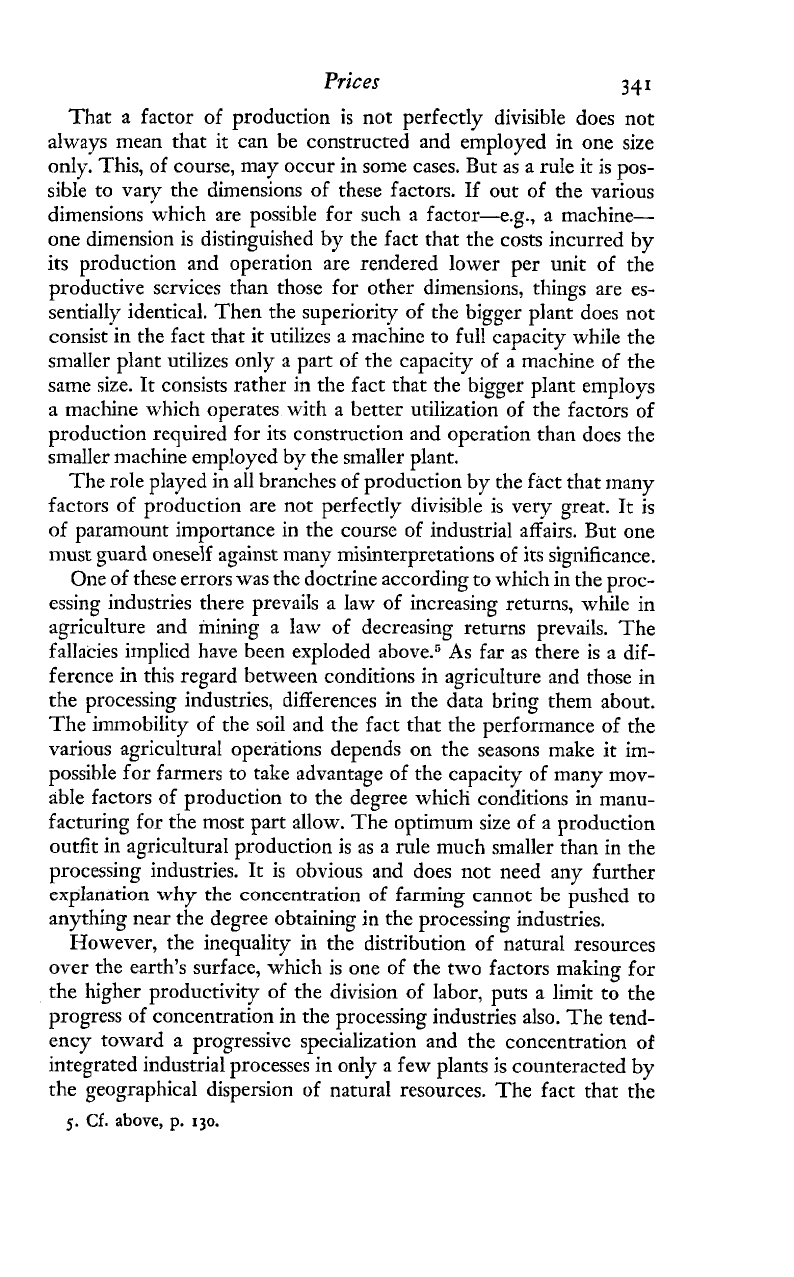
Prices
341
That a factor of production is not perfectly divisible does not
always
mean that it
can
be constructed and employed in one size
only. This, of course, may occur in some cases. But as a rule it is pos-
sible to vary the dimensions of these factors. If out of the various
dimensions which are possible for such a factor-e.g., a machine-
one dimension is distinguished
by
the fact that the costs incurred by
its production and operation are rendered lower per unit of the
productive services than those for other dimensions, things are es-
sentially identical. Then the superiority of the bigger plant does not
consist in the fact that it utilizes a machine to full capacity while the
smaller plant utilizes only a part of the capacity of a machine of the
same size. It consists rather in the fact that the bigger plant employs
a machine which operates with a better utilization of the factors of
production required for its construction and operation than does the
smaller machine employed by the smaller plant.
The
role played in all branches of production by the fact that many
factors of production are not perfectly divisible is very great. It is
of paramount importance in the course of industrial affairs. But one
must guard oneself against many misinterpretations of its significance.
One of these errors was the doctrine according to which in the proc-
essing industries there prevails a law of increasing returns, while in
agriculture and mining
a
law of decreasing returns prevails. The
fallacies implied have been exploded above."s far as there is a dif-
ference in this regard between conditions in agriculture and those in
the processing industries, differences in the data bring them about.
The immobility of the soil and the fact that the performance of the
various agricultural operations depends on the seasons make it
im-
possible for farmers to take advantage of the capacity of many mov-
able factors of production to the degree which conditions in manu-
facturing for the most part allow. The optimum size of a production
outfit in agricultural production is as a rule much smaller than in the
processing industries. It is obvious and does not need any further
explanation why the concentration of farming cannot be pushed to
anything near the degree obtaining in the processing industries.
However, the inequality in the distribution of natural resources
over the earth's surface, which is one of the two factors making for
the higher productivity of the division of labor, puts a limit to the
progress of concentration in the processing industries also. The tend-
ency toward a progressive specialization and the concentration of
integrated industrial processes in only a few plants is counteracted
by
the geographical dispersion of natural resources. The fact that the
5.
Cf.
above,
p.
130.
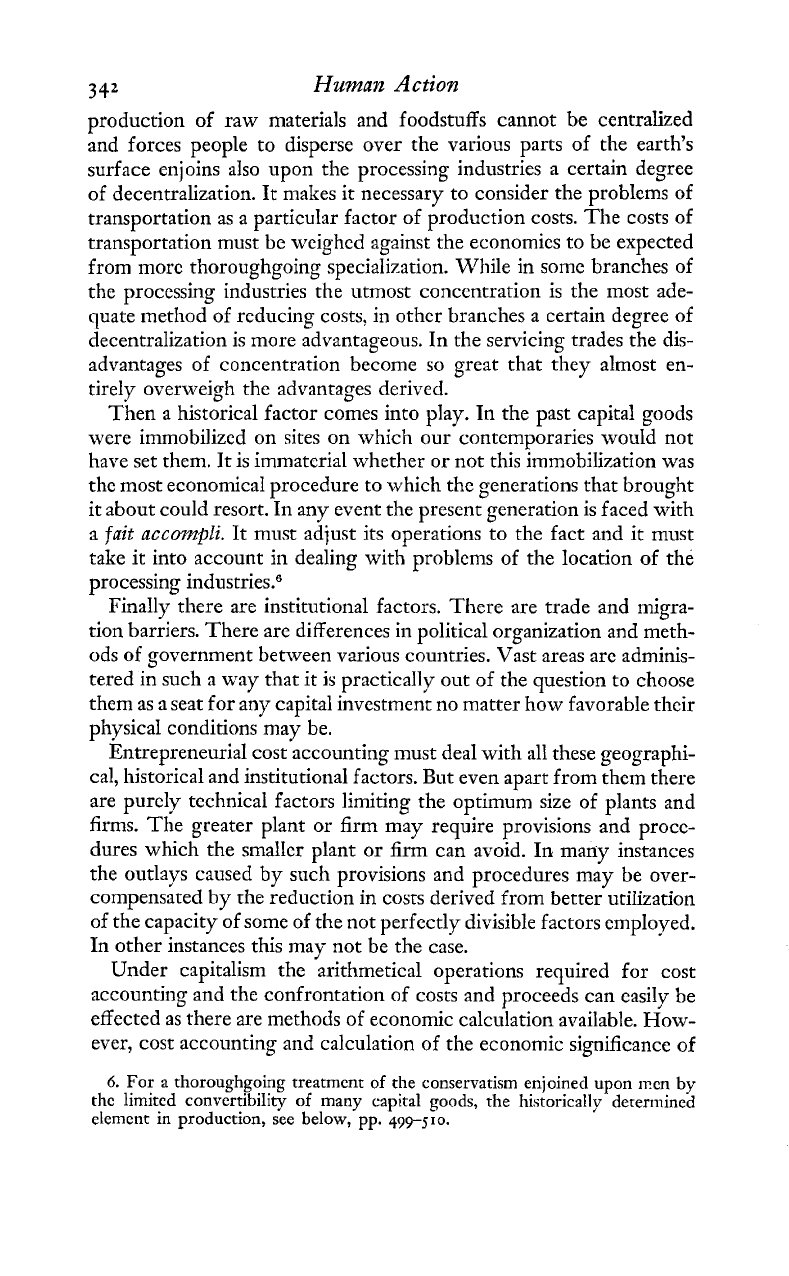
342
Human
Action
production of raw materials and foodstuffs cannot be centralized
and forces people to disperse over the various parts of the earth's
surface enjoins also upon the processing industries a certain degree
of decentralization. It makes it necessary to consider the problems of
transportation as a particular factor of production costs. The costs of
transportation must be weighed against the economies to be expected
from more thoroughgoing specialization. W7hile in some branches of
the processing industries the utmost concentration is the most ade-
quate
net hod
of reducing costs, in other branches a certain degree of
decentralization is more advantageous. In the servicing trades the dis-
advantages of concentration become so great that they almost en-
tirely overweigh the advantages derived.
Then a historical factor comes into play. In the past capital goods
were immobilized on sites on which our contemporaries would not
have set them. It is immaterial whether or not this immobilization was
the most economical procedure to which the generations that brought
it about could resort. In any event the present generation is faced with
a
fait
accompli.
It must adjust its operations to the fact and it must
take
it
into account in dealing with problems of the location of the
processing ind~stries.~
Finally there are institutional factors. There are trade and migra-
tion barriers. There are differences in political organization and meth-
ods of government between various countries. Vast areas are adminis-
tered in such a way that it is practically out of the question to choose
them as a seat for any capital investment no matter how favorable their
physical conditions may be.
Entrepreneurial cost accounting must deal with all these geographi-
cal, hjstorical and institutional factors. But even apart from them there
are purely tcchnical factors
limiting
the optimum size of plants and
firms. The greater plant or firm may require provisions and proce-
dures which the smaller plant or firm can avoid.
In:
many instances
the outlays caused by such provisions and procedures may be over-
compensated by the reduction in costs derived from better utiiization
of the capacity of some of the not perfectly divisible factors employed.
In other instances this may not be the case.
Under capitalism the irithmetical operations required for cost
accounting and the confrontation of costs and proceeds can easily be
effected as there are methods of economic calculation available. How-
ever, cost accounting and calculation of the economic significance of
6.
For a thoroughgoing treatment of the conservatism enjoined upon men
by
the limited convertibility of many capital goods, the historically determined
element
in
production, see below, pp.
499-510.
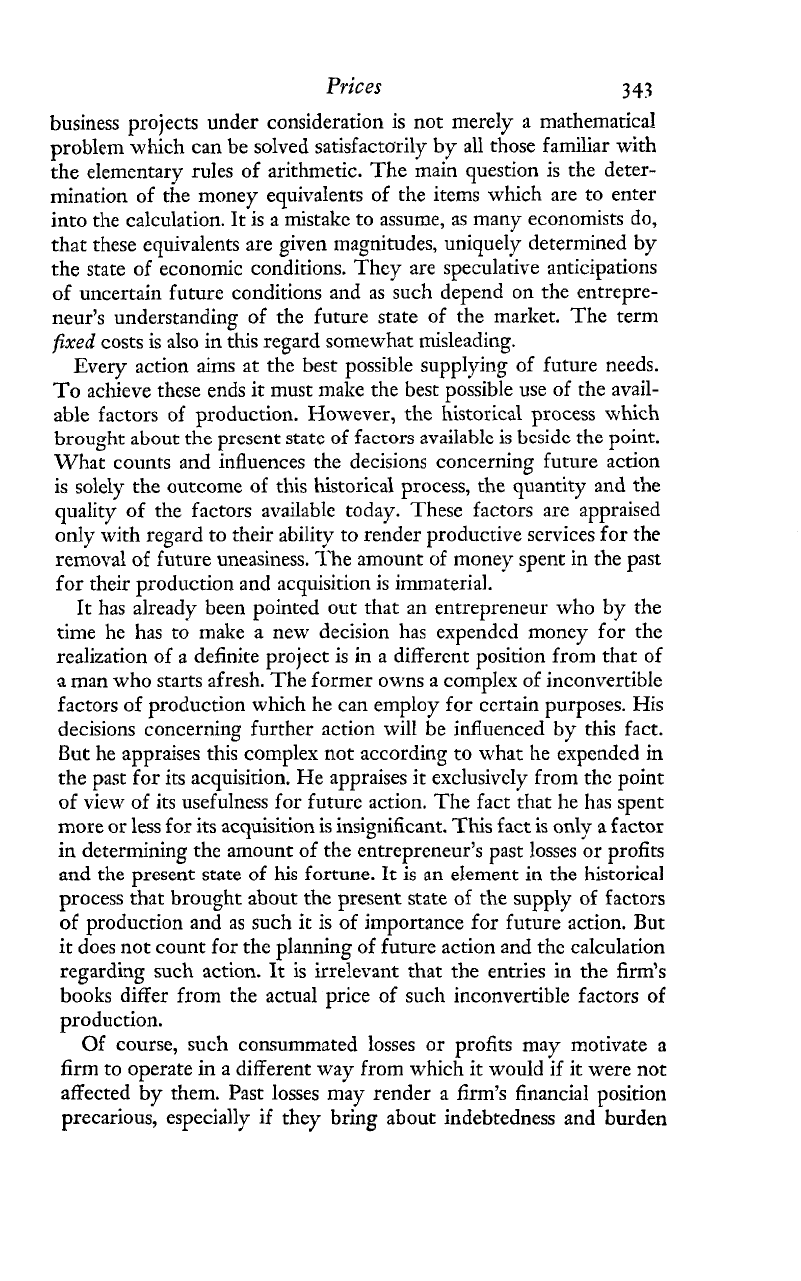
Prices
business projects under consideration is not merely a mathematical
problem which can be solved satisfactorily by all those familiar with
the elementary rules of arithmetic. The main question is the deter-
mination of the money equivalents of the items which are to enter
into the cakulation. It is a mistake to assume, as many economists do,
that these equivalents are given magnitudes, uniquely determined by
the state of economic conditions. They are speculative anticipations
of uncertain future conditions and as such depend on the entrepre-
neur's understanding of the future state of the market. The term
fixed
costs is also in this regard somewhat misleading.
Every action aims at the best possible supplying of future needs.
To achicve these ends it must make the best possible use of the avail-
able factors of production. However, the historical process which
brought about the present state of factors available is beside the point.
What counts and influences the decisions concerning future action
is solely the outcome
of
this historical process, the quantity and the
quality of the factors available today. These factors are appraised
only with regard to their ability to render producrive services for the
removal
of
future uneasiness. The amount of money spent in the past
for their production and acquisition is immaterial.
It has already been pointed out that an entrepreneur who by the
time he has to make a new decision has expended money for the
realization of a definite project is in a differcnt position from that of
a
man who starts afresh. The former owns a complex of inconvertible
factors of production which he can employ for ccrtain purposes. His
decisions concerning further action will be influenced by this fact.
But
he appraises this complex not according to what he expended in
the past for its acquisition. He appraises it exclusively from the point
of view of its usefulness for future action. The fact that he has spent
more or less for its acquisition is insignificant. This fact is only
a
factor
in determining the amount of the entrepreneur's past losses or profits
and the prescnt state of his fortune. It is an element in the historical
process that brought about the present state of the supply of factors
of production and as such it is of importance for future action. But
it does not count for the planning of future action and the calculation
regarding such action.
It
is irrelevant that the entries in the firm's
books differ from the actual price of such inconvertible factors of
production.
Of course, such consummated losses or profits may motivate
a
firm to operate in a different way from which it would if it were not
affected by them. Past losses may render a firm's financial position
precarious, especially if they bring about indebtedness and burden
